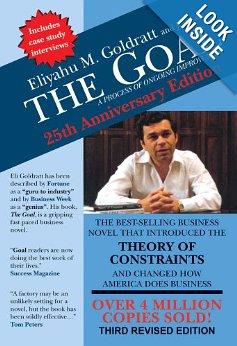A good definition of a goal is one that sets us on a path of ongoing improvement. Pursuing such a goal necessitates more than one breakthrough. In fact it requires many. – Eliyahu Goldratt
I have to thank my friends at copyblogger media for mentioning this book during one of the many webinars they host for authority members.
In “The Goal“, Eliyahu Goldratt uses a factory as the setting for a novel that teaches how pursuing goal or set of goals leads to a path of ongoing improvement.
Goldratt tells the story of how Alex Rogo, the plant manager overcomes the problems in his factory with the help of his long lost cigar smoking Physics professor from who had never run a manufacturing plant.
Jonah believes that scientific methods when properly applied can be used to solve all problems in business and life.
Rather than tell Alex what to do, Jonah provokes Alex to arrive at his own solutions by the process of deductive reasoning.
Here are a few things I have learnt from “The Goal
1. Know your purpose.
What is the true output or measure of your effort. Identifying the goal of your business or why you are doing what you do will help you keep on track. It also serves to help you focus on what is truly important. “Productivity is meaningless if you do not know what your goal is.
2. Use goals as a moving target
The goal of an individual or organization should not be defined in absolute terms. But rather in a manner that allows for the pursuit of ongoing improvement
3.Everything you do taking you to or away from your goal
All activities you are engaged in are either taking you towards you goal or taking you away from your goal. There is no neutral position. So knowing what you stand for and clearly defining the goal of your organisation becomes a prerequisite for success.
You are productive if what you are doing is taking you towards your goal. And you are unproductive if your activities are taking you away from your goal.
4. Think like a scientist
The need to think of science as the ability to challenge the status quo and think logically daily about what we see. We do not need more brain power says Goldratt, what we need more of is the ability to think logically and precisely about what we see.
This reminds me of the story of a man called Adam who was out fishing with his friend. Every time Adam caught a fish, he would measure its length against a pre cut piece of wood he held in his bag. Any fish that was longer than the slick, would get thrown back into the river. Any fish smaller than the stick would be thrown into a bag to take home to his wife. Looking puzzled, his friend asked, “why are you throwing the big fish back into the river and only keeping the small ones”. He had no answer other than thats how I have been doing it for years.
On getting home, Adam asked his wife Jenny why she liked to cook only the small fish and not the big ones. “Thats how my mother thought me she replied”. When she met her mum a few days letter and asked the same question, mum simply replied, “that’s how my mother cooks her fish.
Jenny picked up the phone and rang nanny. To Jenny’s surprise, nanny explained why she always cooked small fish no longer than 6 inches in length. Nanny simply said “because my frying pan can not hold anything longer than 6 inches”.
The assumptions we work and live by may have been true many years ago, but do they remain true today?
4. Not all constraints can be removed.
In a set of processes, or chain, the overall productivity is limited by the capacity of the weakest link. If this links is an essential process, productivity can be increased by redesigning your work to lighten the load on the bottle neck thus increasing its capacity to produce.
The book is set in the manufacturing era of the 1980’s and all the illustrations come from engineering and production. “The Goal” is about manufacturing principles and about the people trying to improve their factory output by applying the theory of constraint in identifying and overcoming bottleneck in the production process.
As individuals and businesses, our output is also limited by the bottleneck or constraints we face. We learn, grow and increase our capacity for productive work as we know and understand what our true goal is, identify the constraints in our lives and then and overcome the identified constraints.
Leave a comment if you have read “The Goal”.

